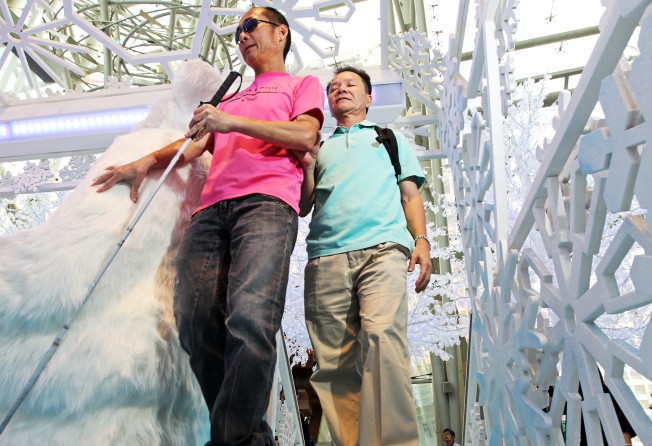Why are people so afraid of those with a disability?
Peter Kammerer laments the way the able-bodied avoid those who are different, missing out on the chance of greater understanding and friendship

A blind guy goes into a supermarket in Causeway Bay in search of the sandwich counter. This is no joke: the only people around are staff stocking shelves and they scatter whenever he approaches to ask for help. Presumably, they are afraid of those who look different and don't know what to do or say - so rather than have what they believe will be an uncomfortable experience, they prefer to avoid it. Eventually, another shopper shows up and the ciabatta with chicken and salad is obtained, paid for and the tall man with the white cane goes on his way.
The man is, of course, me. I had not been to the shop before, so was confused by the labyrinthine layout; all I knew was that the sandwiches there were recommended. I am not adventurous, merely independent. People who impart admiring comments when encountering me are met with an "I do what I have to" and those inquiring why a "friend" has not accompanied me are given a simple "I don't have one".
That's how it should be: I will not find out about my surroundings or meet strangers, nor will others get to know about those with disabilities, if there's someone providing a comfortable cushion of separation. Only through interaction will the unfamiliar become familiar. It's a learning process for both sides. The problem is a lot of people are afraid to find out.
Like Sunday afternoon, when I encountered an elderly woman with a shopping trolley waiting at a bus stop in North Point. She had seen and heard me coming and pushed the trolley in front of me and gave it a push for added emphasis. A job-hungry lawyer would call this assault, but I experience this on such a regular basis that if I took legal action every time, the courts would label me a troublemaker. So I turned to the woman and calmly asked her why she had done that. In perfect English, she explained that my cane was dangerous and I had been about to hurt her. My cane is made of fibreglass and weighs a few dozen grams; brushing against a shoe – which is all that would have happened – would have done no more than make a dull thud. I told her this, but she was having none of it. Educating on my mind, I held the cane out to her at arm’s length, the tip pointing to the ground, urging her to hold it to see how light and inoffensive it was. She angrily told me not to point it at her, repeating how dangerous I was to her. Not wishing to escalate a hopeless situation into a heated argument, I shrugged my shoulders and walked off.
Too many are awkward around those who can't see, walk, talk or hear. That is despite the World Health Organisation estimating that more than 15 per cent of the global population - about 785 million - has a significant physical or mental disability. But polite society is taught not to stare at that which is different and to avoid the unusual. The result is a lack of understanding and lost relationships.
For me, this can lead to frustrations and annoyance. It's why I make a point of learning in detail about places I intend to go regularly. The gym I joined last week was first visited with a friend and as much as possible memorised. A colleague believes life should involve constant education, whether through learning a language or musical instrument or study. I do none of these because my existence involves constant learning about more practical matters like how to find the sandwich counter or elliptical machine.

Going to the gym the first time by myself was a roller-coaster event. Hundreds of details had been memorised and that memory was now being tested. How to get from the tram stop to the mall; finding the escalators, then the correct lift (on the right side of the restaurant); which button to press (third from the bottom on the left); where the various pieces of equipment are and how to use them; the location of the changing room, showers, steam room and sauna; where to put used towels; and which gate to exit through. I also need to know where the women's changing room is, so that it is not entered by mistake, among much, much else. Sharp corners of walls, tricky street crossings and shop renovations are uppermost in the memory as they could involve wounds or even be matters of life and death.
Frequency means that familiar surroundings, such as my home, neighbourhood and office are easily navigated - so much so that there are those who don't believe I can't see. Switching off my computer screen at work to prove that I use speech software turns such people into believers. But that's only a small part of increasing interaction. Respecting people and seeing beyond their disability is the biggest challenge.
False assumptions and incorrect stereotypes will be cleared up only by getting to know those who have a disability. That education will never happen for those who run away or are afraid of saying the wrong thing.
Peter Kammerer is a senior writer at the Post